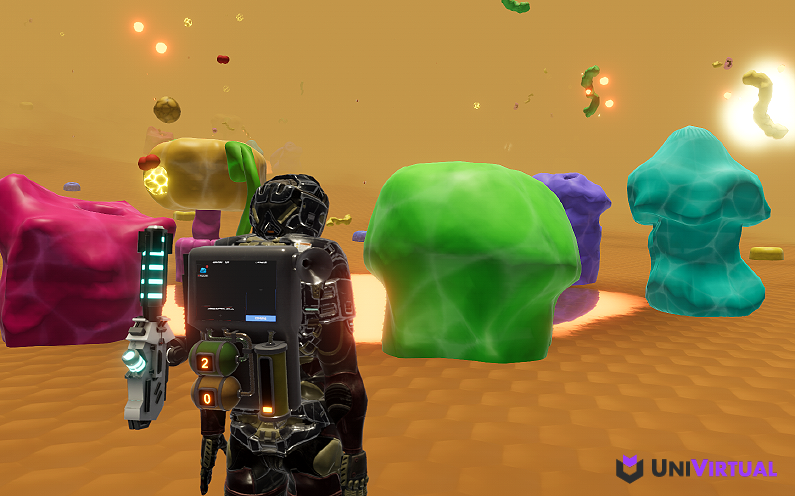If you’re tuned into the virtual world, you may have seen Facebook announce their new name: Meta. This change reflects their commitment to the Metaverse, a VR/AR world described as the next evolution of social connection.
The Metaverse will consist of immersive, 3D spaces in which you can work, socialize, learn, collaborate, and play. In effect, it would become a new digital layer in our lives and “feel like a hybrid of today’s online social experiences, sometimes expanded into three dimensions or projected into the physical world.”
Globally, companies and individuals will be able to create virtual spaces within the Metaverse as a collective, and it will be open to everyone. How can we ensure Diversity, Equity, and Inclusion is part of this new collaborative, virtual part of our lives? Answering this question is the focus of our partner company, Future Work Institute. Together, we’d like to share what we believe should be the first steps for anyone considering building virtually, in the Metaverse or otherwise. Without efforts to address challenges facing diverse and marginalised groups, existing divides and inequities will only be reinforced in VR.
IMAGE: UniVirtual’s Mars Surface Habitat
Developing Collaboratively
Involving marginalized groups and diverse communities as early as possible within the development of the Metaverse will help ensure steps are taken to address challenges they might face. This doesn’t mean simply seeking their feedback along the way. Actively including these individuals and communities in the creation process—such as hiring and training them as developers—helps ensure platforms where they are involved and listened to.
Providing Tools for Safe Exposure and Exchange
Like any virtual space, the Metaverse will bring people together. This greatly benefits isolated individuals, as an online world can mean meeting more easily. It also offers opportunities to learn and practice social skills, such as users with Asperger’s Syndrome who may find this more difficult in real life. Once users create these safe spaces and support groups for themselves, they can also choose to invite outsiders and allies to listen and participate within those spaces.
It is essential that tools are provided that expose and facilitate exchanges with the rest of the digital population to ensure any existing real-world isolation is not transferred to the virtual one. However, with increased exposure and a growing number of participants, safe spaces need to stay that way. Being able to moderate the space, or at the very least offer communities tools to moderate them themselves, will be essential. Additionally, strict policies, restrictions, and transparency of their application are important.
IMAGE: UniVirtual’s Avatar Creator
Prioritising Accessibility
To ensure virtual accessibility, we should look to existing technologies and services and consider how best to integrate them into the Metaverse. The more the Metaverse expands, the more it will become a simulation or twin of the real world where accessibility solutions are relevant and included. With more users online at a given time, the more people will be present to assist when someone requires it and the more users with specific accessibility requirements can offer live feedback to those developing it.
Take a hearing-impaired individual, for example. The common practice of hiring an ASL interpreter could be integrated easily to a virtual space. As a first step: projecting their live feed onto a user’s screen. After that, technology could be developed to further that user’s immersion. The interpreter might have an avatar equipped with a haptic device capable of reproducing their hand movements virtually.
It is not only infrastructures and interfaces that need to be accessible, however. Virtual content itself should be able to support a wide variety of users, from the size and height of an enclosed space to the color of interactive objects.

IMAGE: UniVirtual learning module – Labeled animatic with audio description
Offering Inclusive Support
Any new technology brings its share of bugs and outages. These can be aggravating to individuals with diverse needs who might already be struggling with operating new technology and participation. Requesting support might be yet another challenge they must overcome as accessibility is the support/reporting process is often overlooked. Therefore, in the case that something goes wrong, requesting and receiving support should be an experience that is as accessible and inclusive as the platform itself, if not more so.
Role of the Diversity, Equity, and Inclusion (DEI) Professional
Involving internal or external DEI professionals is essential when setting up your Metaverse. Here are some ideas about how to get DEI professionals involved from the early stages of development:
- Metaverse developers need to be trained on assessing the behavior landscape with DEI professionals as co-facilitators.
- DEI professionals should be involved in recruiting local community managers with some experience in managing disruptive behaviors.
- DEI professionals should work with metaverse developers and testers to create best-in-class member Codes of Conduct and Community Guidelines.
- DEI professionals should regularly monitor disruptive behavior reports and suggest remedial action when needed.

